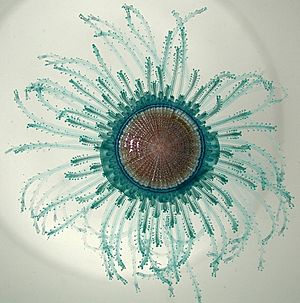Chondrophore facts for kids
Quick facts for kids Chondrophores |
|
|---|---|
 |
|
| Blue button (Porpita porpita) | |
| Scientific classification |
|
| Kingdom: | Animalia |
| Phylum: | Cnidaria |
| Class: | Hydrozoa |
| Order: | Anthoathecata |
| Suborder: | Capitata |
| Family: | Porpitidae Goldfuss, 1818 |
| Type genus | |
| Porpita |
|
| Genera | |
|
|
| Synonyms | |
|
|
Chondrophores (say "KON-dro-fores") are a special group of sea animals. They are also called porpitids. These creatures are part of the Porpitidae family. They are a type of hydrozoan, which are tiny animals related to jellyfish and corals.
These amazing animals live on the surface of the open ocean. They float freely and are actually groups of many small animals living together. They are like tiny floating cities! Chondrophores eat other small sea creatures, making them carnivores. Even though they look like a single animal, they are really a team of many tiny parts called polyps working together.
The most famous chondrophores are the blue button (Porpita porpita) and the by-the-wind sailor (Velella velella).
Contents
What are Chondrophores?
Chondrophores might look like a jellyfish, but they are quite different. A jellyfish is one animal. Chondrophores are not a single animal at all! They are a colony of many tiny, individual parts. Each part is called a zooid (say "ZOH-oid").
Zooids: Tiny Team Players
Imagine a team where each player has a special job. That's how zooids work! Each zooid is a small, changed polyp. They are all genetically identical, meaning they are like clones of each other. But they cannot live alone. Each zooid is attached to the others, and they all depend on each other to survive.
For example, some zooids might be in charge of catching food. Others might help the colony float, or reproduce. They all work together to keep the whole colony alive.
Chondrophores vs. Siphonophores
This teamwork idea is also seen in another group called siphonophores. The most famous siphonophore is the Portuguese man o' war. Like chondrophores, the Portuguese man o' war is also a colony of zooids.
However, chondrophores and siphonophores are not the same. They evolved separately, meaning they developed their colony structure on their own. Scientists place them in different groups, or "orders," because of these differences.
Ancient History of Chondrophores
Scientists have found very old evidence of chondrophores. A rare fossil of a soft-bodied creature was discovered in Kentucky, USA. This fossil came from rocks formed during the Mississippian period, which was about 359 to 318 million years ago. Scientists believe this fossil was a part of an ancient chondrophore that helped it float.
This suggests that chondrophores are very old. They likely first appeared in the Neoproterozoic era. This era was a long, long time ago, between 650 and 540 million years ago!
Images for kids


